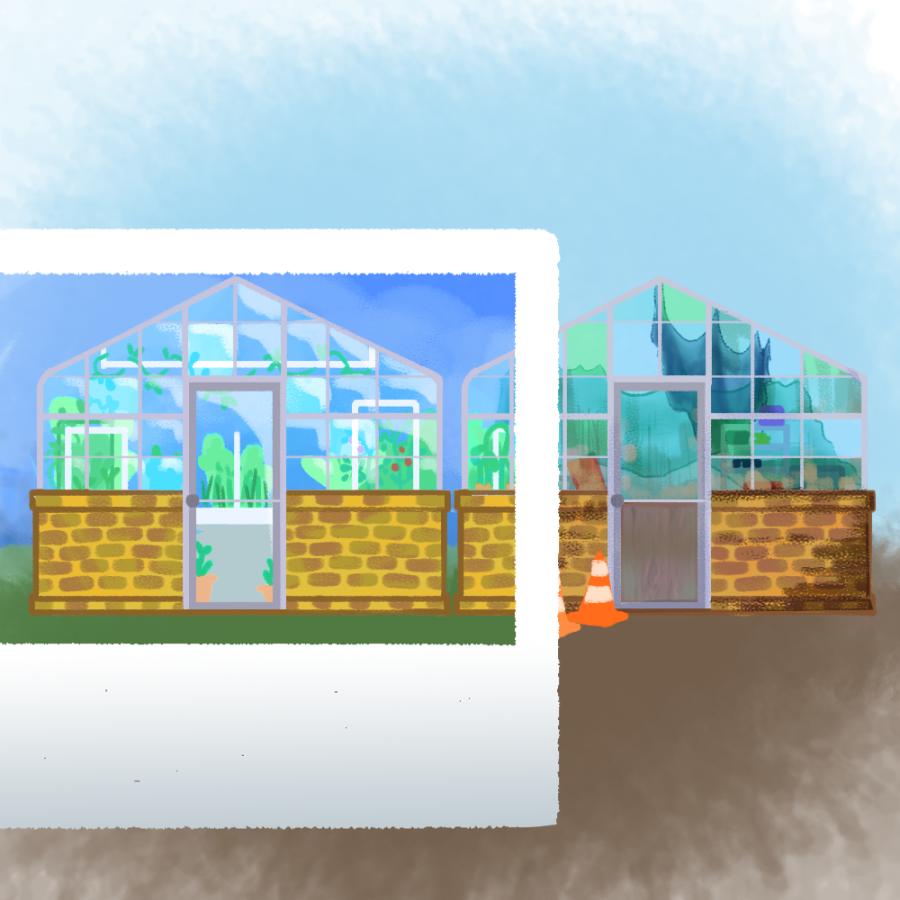Aquaponics navigates broken greenhouse, shows creativity in face of adversity
February 1, 2022
Filled with lush greenery and bobbing iridescent fish, the Painter Greenhouse, which sits right behind Painter Hall, once served as a space for project-building, experimentation and community gathering. For the Aquaponics club, it was home.
However, after sustaining extensive damages as a result of Winter Storm Uri and the hailstorm that followed, the greenhouse, now filled with broken pipes and shattered window panes, dons a much grimmer appearance.
An environmentally conscious method of agriculture, aquaponics involves a blend of raising fish and growing plants without the use of soil. UT’s Aquaponics club allows undergraduates to learn about sustainability while also developing engineering skills through design, team collaboration and leadership. However, according to Aquaponics club co-leaders Zoe Welch and Anh Nguyen, with limited resources and no greenhouse, they can’t replicate the fun hands-on experience.
“That’s what made me fall in love with (Aquaponics), I get to physically touch things,” environmental engineering senior Welch said. “It’s not just research, not just on my computer, you get so much of that in class (already).”
On top of helping members gain practical skills, Nguyen, a mechanical engineering senior, said the greenhouse fostered a strong sense of community, allowing members to feel more welcome.
“It (kept) our engagement going, just being at the greenhouse allowed us to hang around and talk,” Nguyen said. “We (were) always doing something in there. Since it’s out in the open with sunlight passing through, (it) helps people feel more comfortable rather than listening to someone talk or lecture.”
For environmental engineering and Plan II senior Sara Murillo, Aquaponics stands out because of its emphasis on inclusivity. Contrasting the male-dominated Cockrell School of Engineering, the majority of Aquaponics is female, and regardless of experience level, she said the group always made her feel valued.
“In (Aquaponics), it’s all about encouraging participation and learning,” Murillo said. “Even people who know way more than me are super willing to listen to my ideas.”
Despite the open and engaging environment, without access to the greenhouse, Murillo said they no longer have adequate space to grow plant beds or the opportunity to mimic industry standards.
“The things we actually need are in the greenhouse, and we can’t take all that out,” Nguyen said. “We’re keeping our project floating as is, and (we’re) trying to think of other possibilities.”
Aquaponics’ newest project idea involves developing a mobile aquaponics system for outreach events. Despite not having the greenhouse, Welch and Nguyen said they continue to maintain club operations.
“I think with a lot of other leaders, the group would’ve just completely dissipated, but Zoe and Anh are determined,” Murillo said.
In hopes of finally being able to repair the greenhouse, both Welch and Nguyen plan to apply for UT’s Green Fund — a competitive grant program funded by student tuition that subsidizes sustainability-related projects led by students, faculty and staff.
In 2017, the Green Fund committee granted Aquaponics $17,000 to refurbish the worn-down Painter Greenhouse. This time, Aquaponics hopes the Green Fund will once again grant them money to repair the damage.
“It’s a great project that has produced some kind of impact to either the campus scenery or to the student body itself,” Nguyen said. “I’m hopeful about getting some money from this and moving forward with Aquaponics.”
Jill Parrish, staff member at UT’s Office of Sustainability and manager of the Green Fund program, said she admires Aquaponics’ flexibility and creativity despite the many challenges they’ve faced.
“I’m in awe of them,” Parrish said. “My favorite part of my job is interacting with students that exhibit such passion and creativity and perseverance for sustainability and are able to continue in the face of adversity.”












